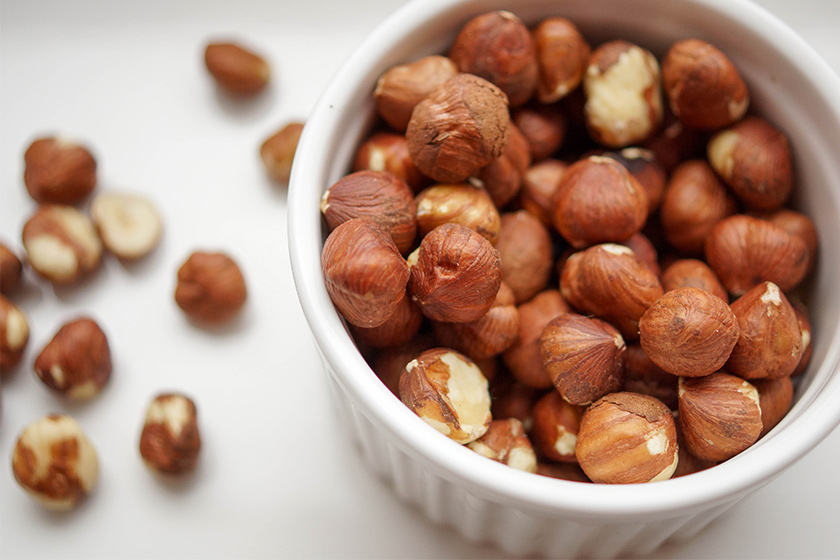
I especially love roasted nuts. And one benefit of roasting them is clear — if you think roasted nuts taste better — then roasting will encourage you to include them in your diet.
My kitchen is always stocked with some kind of nuts. With so much variety they literally work with anything and add a dose of crunch and goodness to whatever it is you’re eating. All nuts have different nutrition benefits and offer valuable vitamins and minerals that are vital to a healthy diet. Plus, not only do they taste great, they also make great snacks.
So if you aren’t familiar with roasting, let’s take a look at how easy it is:
STOVETOP METHOD:
In a heavy bottomed saucepan or skillet spread the nuts out in a single layer.

Heat on medium-high. Do not add any oil or cooking spray. Stir or shake frequently for 5-10 minutes or until nuts are fragrant and turn golden brown.
Remove from heat, and transfer to a plate, otherwise they will continue to cook after being removed from the heat.
OVEN METHOD:
Preheat oven to 350° F / 180°C. Spread nuts evenly in a single layer in a shallow pan.

Bake in middle of oven for about 10-15 minutes, stirring every 5 minutes or so until nuts become fragrant (in the case of hazelnuts, the skins begin to crack). See below table for guide to roasting times.
Be sure to keep an eye on your nuts and check them every few minutes to avoid overcooking them, otherwise they will taste bitter and burnt.
Remove immediately from the pan, otherwise the nuts will continue browning after you’ve removed them from the oven.
| Nuss: | Backzeit: |
| Almonds (sliced) | 7 – 10 Minutes |
| Almonds (whole) | 10 Minutes |
| Chestnuts | 25 Minutes |
| Haselnuts | 12 – 15 Minutes |
| Pecan Nuts | 10 – 15 Minutes |
| Pine Nuts | 5 Minutes |
| Walnuts | 10 – 15 Minutes |
| Peanuts (shelled) | 15 – 20 Minutes |
| Peanuts (whole) | 20 – 25 Minutes |
NOTE: Ovens heat differently, so your timing may vary slightly.
SKINNING NUTS
If you have toasted nuts that have skins on them (e.g. peanuts or hazelnuts), simply allow them to cool for a few minutes and once cool enough to handle, place the nuts in a clean, dry kitchen towel and rub them vigorously.

You can also use your bare fingers since the skins will slip right off.
Don’t worry if there are any remaining skins. A small amount of skin remaining on the nuts is completely normal and safe to eat.
So how about health benefits of including nuts in your diet?
Here’s a VERY brief overview:
Almonds* – calcium-rich, high in vitamin E — good for your bones and your skin. Aside from chestnuts, the only nut that is alkaline forming – important to maintaining your health and preventing cancer.
Brazil Nuts*** – good source of the mineral selenium — ideal for those with a low thyroid function.
Cashews*** – rich in magnesium, with notable levels of protein and minerals like iron and zinc — excellent choice if you’re following a vegetarian diet — you only need 3 or 4 of them for the full benefit.
Chestnuts* – rich in starchy carbs and fibre, B vitamins including B6 — by far the nut with the lowest fat and calories.
Hazelnuts* – good source of folate which regulates an amino acid called homocysteine – in turn effectively reduces the risk of heart problems.
Pecans** – packed with plant sterols, rich in oleic acid (that’s the healthy fat found in avocado), and loaded with antioxidants — heart-friendly and effective at lowering cholesterol levels.
Pine Nuts*** – good source of heart-healthy monounsaturated fat, vitamin E and zinc, nutrients — great for improving cardiovascular health and maintaining healthy eyes, skin, and hair.
Pistachios** – rich in vitamin B6 which keeps hormones balanced and healthy. Plus it’s the only nut that contains a reasonable levels of lutein and zeaxanthin — two antioxidants that play an important role in protecting the eyes.
Walnuts** – superior antioxidant content – important for fighting against cancer good, plus it’s a good source of mono-unsaturated, heart-friendly fats, which help to lower the bad form of cholesterol. Don’t forget rich in omega-3, so a great alternative if you don’t eat oily fish.
***high saturated fat content
**medium saturated fat content
*low saturated fat content




